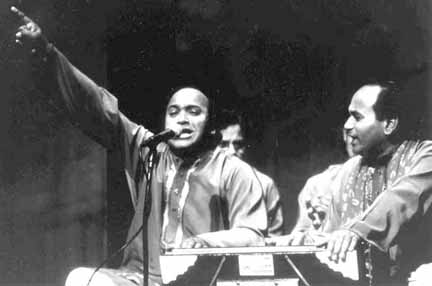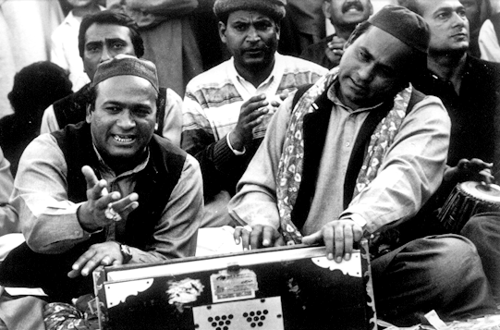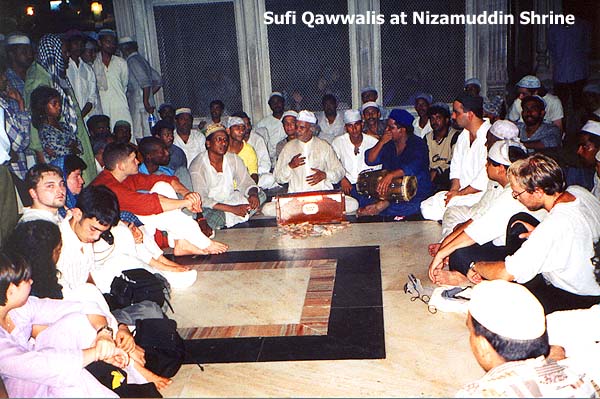Qawwali is the traditional form of Islamic song found in India and Pakistan. The word qawwali is derived from the Arabic word Qaol which means "axiom" or "dictum". A Qawwal is one who sings qawwali, or the dictums of the prophets and praises of God. The Qawwali is closely linked to the spiritual and artistic life of northern India and Pakistan.

SPIRITUAL ASPECT OF QAWWALI
The qawwali is inextricably linked to the Sufi tradition; Sufism is a mystical
school of Islamic thought which strives to attain truth and divine love by direct
personal experience. In Arabic, this mysticism is known as tasawwuf. The difference
between Sufism and mainstream Islam is simple. All Muslims believe that man
is on a path to God (tariqah). However where the mainstream Muslim believes
that it is only possible to reach God after death at the final judgement, the
Sufi believes that it is possible to reach God during ones life. To this end
there are a number of different techniques and methods.
The Koran instructs man to remember God. This remembrance, known as dhikr, may be either silent of vocal. The qawwali may be viewed as an extension of the vocal form of this remembrance. The use of music as a spiritual force was discussed in great length by al-Gazali(1085-1111).
By the end of the 11th century there arose the tradition of the sama. The sama was often a spiritual concert, which included a vocalist, and instrumentalists. These samas took place under the direction of a spiritually respected man (shaikh).
There is a very specific psychological process which a qawwali follows. One starts with the singing of the song. In this psychological state the song is received in a manner that is not unlike standard forms of musical expression. The words are sung, quite repeatedly with variations intended to bring out deeper means of the lyrics. After awhile there is a repetition to the extent that the words cease to have a meaning; It is the goal here to lead the listener and performer alike into a trance (hal). In the ideal situation the participant is moved to a state of spiritual enlightenment (fana).

HISTORY OF THE QAWWALI
The origins of qawwali probably predate the birth of Muhammad. The earliest
Islamic scholars discussed the spiritual effects of music, but it was only in
the time of al-Gazali(1085-1111) that these principles were refined and codified.
These principles were then expanded by the Chisti school of Sufism. It is this order that has been responsible for the propagation of the qawwali in India and Pakistan for then last few centuries.
The Chisti school was established by Khwaj Moinuddin Hasan Chisti (1143-1234). It is said that he was born in Sijistan. At a young age he was influenced by several saintly men, including Ibrahim Qahandazi, and Shaikh Abdul Qadir Jilli. He immigrated to Delhi and became a very respected saint. He later grew tired of the life in Delhi and withdrew to the peace and quite of Ajmer (Rajasthan) where he lived the remainder of his days.
One of the followers of the Chisti school was a man by the name of Shaikh Nizamuddin Auliya (1236-1325). He was born in Budaun, but at the age of 20 he moved to Ajodhan and became a disciple of Fariduddin Ganj-i-Shakkar. It is said that it was here that he received the key to inner illumination. He was then sent to Delhi to instruct the populous. Here he acquired a reputation for using music in his devotional gatherings. This created a great amount of friction with the more orthodox Islamic elements in Delhi.
Nizamuddin Auliya was, and still is, a source of inspiration for countless people. Even today there is an annual gathering at his tomb.
One man who was inspired by the Hazrat Nizamuddin was Amir Khusru (1254-1324). He was born in Mominpur (Patiala). His father was originally from Turkey, this gave the young boy a broader exposure to the rest of the Islamic world. His father died when he was eight years old, whereupon the job of raising him fell to his maternal grandfather. Amir Khusru was a legendary musician, statesman and philosopher. It is said that he was the advisor to 11 rulers of Delhi, particularly the rulers of the Khilji Dynasty (Deva 1973:76).
Amir Khusru is so important to the development of qawwali that he is often (erroneously) said to be the inventor of it. It is said that he mixed the various musical elements from Turkey, greater Persia and India together. Even today, we find the curious mixture of Persian moqquams with Indian rags.
The development of the qawwali up to the latter part of the Mogul empire closely parallels the development of the Hindu religious song known as bhajan. We find parallels in musical form and social settings. The degree of cross influence is so great that some musician / saints such as Kabir (circa 1440-1518) are to this day revered by Hindus and Muslims alike.
The tradition of qawwali has had numerous ups and downs. One particularly hard time was during the reign of Aurangzeb. Aurangzeb is known for his Islamic fundamentalism. The liberal traditions of the Sufis were not well received by this emperor. He took the fundamentalist injunction against music very seriously.
Aurangzeb's dislike of music is well illustrated in a common story. It appears that during his administration a group of musicians, disheartened with their lack of patronage, took some musical instruments and wrapped them in the manner of a corpse and held a funeral procession in protest. Aurangzeb enquires about the procession and is told it is a burial to signify the death of music. Whereupon it is said that the emperor declares, "Good! bury it so deep that never a sound should be heard again."
The collapse of the Mogul empire and political fragmentation under the British was both good and bad for the qawwals. On one hand the political disarray meant that a major suppression of their artform was impossible, yet it also meant that their patronage was also uneven.
The rising film industry in the middle of the 20th century was a major vehicle for the rise in popularity of the qawwali. There was a period when a qawwali was a mandatory part of the formula Hindi films.
The film industry influenced the development of the qawwali in several ways. It is interesting to note that since the environment of the cinema house precluded the artist /audience interaction, it set the precedent for the more detached quality that characterises modern performances. The filmi qawwali also set the precedent for the "showy" quality that one finds in modern performances. Another effect of the filmi qawwali was the downgrading of the religious / devotional aspect. A typical example of a filmi qawwali is "Sharam ke Kyun Sab" from "Chaudvin ka Chand".
The secularisation of the qawwali is an interesting phenomenon. One can see that the seeds of its secularisation are inherent in the qawwali itself. Themes of qawwali have traditionally revolved around very mundane or even coarse occurrences. However the coarseness of the situations have always been interpreted as the coarse spiritual existence of our daily lives. The modern secular qawwali tends to strip the themes of their metaphorical and allegorical character thus producing a shallow yet commercially marketable entity.
Recent years have seen the qawwali thrust into the international arena by such musicians as Nusrat Fateh Ali Khan. His fusion of traditional Indo-Pakistani influences with Western music has created quite a stir in the music world.
PERFORMANCE CHARACTERISTICS
The performance of a qawwali is typically a group situation. This is different
from a classical performance which revolves around one person. Within this group
situation there is one main vocalist or qawwal, and a group of supporting vocalist.
The audience too is considered a participant in this event
The musical accompaniment is varied; harmonium, tabla, dholak, sarangi, saringda, and rabab, are common instruments. Furthermore, a simple clapping of the hands is a ubiquitous rhythmic support.
There are several tals in common use in the qawwali. The most common is the fast dadra tal of 6 beats or the fast kaherava of four or eight beats. Unlike the more cerebral, classical forms these tals are played in such a way that they produce a driving hypnotic beat.
Although the qawwali is not a classical form of singing, it does have some common elements. One finds fast taans, meend gamaks and the other forms of ornamentation which are typical of Hindustani performances.

The structure of the qawwali is also similar to the classical forms. It typically starts with the alap. This portion has no rhythm and is intended to create the right environment. One then moves into the main portion of the performance; this is usually in a medium tempo. The pace slowly increases until a state of extreme excitement is produced.
It is very common for audience members, moved by their state of ecstasy to give money to the performers. This is known as vel. The performance continues without stopping.
The most common rags used in qawwalis today are bilawal, khammaj, kafi, and kalyan. However one often finds rags which are more in common with the modal forms of Persia or Afghanistan.
CONCLUSION
The qawwali is a very old form of Islamic devotional song. For centuries it
has been inspired and propagated by the Chisti school, of Sufism. Although it
is of Indo-Pakistan origin it is today enjoyed all over the world.
MUSICAL INSTRUMENTS USED
IN QAWWALI
Bulbul Tarang
Dholak
Harmonium
Kartal
Rabab
Santur
Sarangi
Saringda
Tabla
